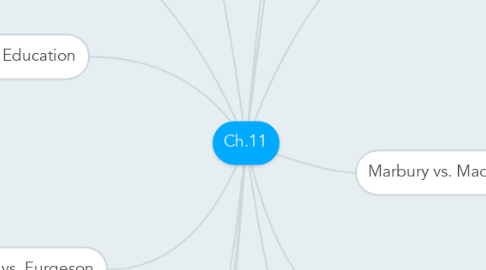Ch.11
by Adam Martinez

1. McCulloch vs. Maryland
1.1. The Court declared that states could not hamper the exercise of legitimate national interests. Maryland had attempted to tax the Bank of the United States.
1.2. This case violates the first amendment, attempting to hinder the pursuit of happiness.
2. Gibbons vs. Ogden
2.1. The Court broadened the meaning of interstate commerce, further extending federal authority at the expense of the states. By 1825 the Court had declared at least one law in each of 10 states unconstitutional.
2.2. The decision in Gibbons v. Ogden survived until 1895, when the court began to limit the congressional power with the case of United States v. E. C.
3. Dred Scott vs. Sandford
3.1. The national furor over the Scott case damaged the Court. It also made an objective evaluation of the Taney era nearly impossible.
3.2. Roger Taney read an opinion that declared African Americans were not and could not be citizens, the Missouri Compromise was unconstitutional, and Congress was powerless to stop the spread of slavery.
4. Plessy vs. Furgeson
4.1. The Court said that a Louisiana law that required railroads operating within the state to provide separate cars for white and African American passengers was a reasonable exercise of state police power to preserve peace and order.
4.2. Plessy legitimized the move toward segregation practices begun earlier in the South and provided an impetus for further segregation laws. Legislative achievements won during the Reconstruction Era were erased through means of the "separate but equal" doctrine.
5. Brown vs. Board of Education
5.1. The Court outlawed segregation in public schools. In several other cases the Court issued rulings that extended equal protection in voting rights and the fair apportionment of representation in Congress and state legislatures.
5.2. The Topeka middle schools had been integrated since 1941. Topeka High School was integrated from its inception in 1871 and its sports teams from 1949 on. The Kansas law permitting segregated schools allowed them only "below the high school level."
6. United States vs. E.C. Knight and Co.
6.1. In 1890, the United States Congress enacted the Sherman Antitrust Act, an attempt to curb concentrations of economic power that significantly reduced competition between businesses.
7. Debs ve. United States
7.1. The case upheld the contempt conviction of labor leader Eugene V. Debs, who had disobeyed an order to call off a strike against a railroad company.
7.2. In 1921, Congress largely repealed the Espionage and Sedition Acts. On December 23, 1921 President Warren G. Harding commuted Debs' sentence to time served, effective Christmas Day. He did not issue a pardon. The two met the following day at the White House.
8. Schechter Poultry Corporation vs. United States
8.1. The case proposed to increase the number of Supreme Court justices. It wanted to pack the Court with supportive members. Even though this attempt failed, the Court began to uphold laws that regulated business.
8.2. In Hyde Park a few days after the decision, Roosevelt denounced the decision as an antiquated interpretation of the Commerce Clause. After the decision was announced, newspapers reported that 500 cases of NIRA code violations were going to be dropped. Glen Asner, a descendent of the Schechters, said that the brothers probably voted for Roosevelt in all four of his presidential campaigns. Their main political concern in the 1930s was anti-Semitism. The Schechters felt that without the New Deal, America could have taken the route of Nazi Germany.
9. Marbury vs. Madison
9.1. William Marbury filed suit in the Supreme Court under a provision of the Judiciary Act of 1789 because he did not receive a commission to become a nominee for a justice of peace.
9.2. Marshall stated that the Judiciary Act of 1789 gave the Supreme Court more power than the Constitution allowed.
10. Fletcher vs. Peck
10.1. The Court held that a law passed by the Georgia legislature was a violation of the Constitution’s protection of contracts.
11. Dartmouth College vs. Woodward
11.1. In 1769 King George III of Great Britain granted a charter to Dartmouth College. This document spelled out the purpose of the school, set up the structure to govern it, and gave land to the college. The Court applied the protection of contracts to corporate characters.
12. Lochner vs. New York
12.1. Lochner supported the state’s right to limit the labor of bakery workers to ten hours per day. His opinion for a unanimous court in Schneck v. United States (1919) established the “clear and present danger" standard in free speech cases
12.2. The Supreme Court's due process jurisprudence over the next three decades was inconsistent, but it took a narrow view of states' police powers in several major labor cases after Lochner.
13. Schenck vs. United States
13.1. Charles Schenck and Elizabeth Baer were members of the Executive Committee of the Socialist Party in Philadelphia, of which Schenck was General Secretary. The executive committee authorized, and Schenck oversaw, printing and mailing more than 15,000 leaflets to men slated for conscription during World War I.
13.2. The leaflets urged men not to submit to the draft, saying "Do not submit to intimidation", "Assert your rights", "If you do not assert and support your rights, you are helping to deny or disparage rights which it is the solemn duty of all citizens and residents of the United States to retain," and urged men not to comply with the draft on the grounds that military conscription constituted involuntary servitude, which is prohibited by the Thirteenth Amendment.
14. Roe vs. Wade
14.1. This case sets down the conditions under which a woman can legally obtain an abortion. In recent years, interest groups have looked closely at the attitudes of potential justices to Roe v. Wade.
14.2. A Gallup poll conducted in May 2009 indicates that a minority of Americans, 37%, believe that abortion should be legal in any or most circumstances, compared to 41% in May 2008.


